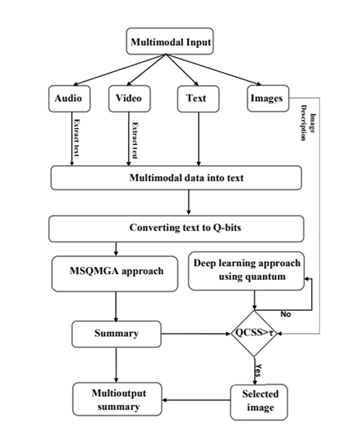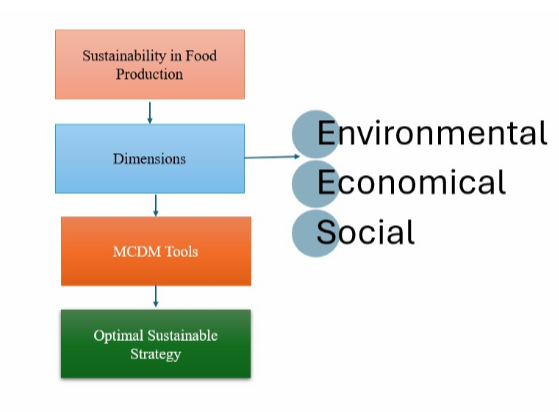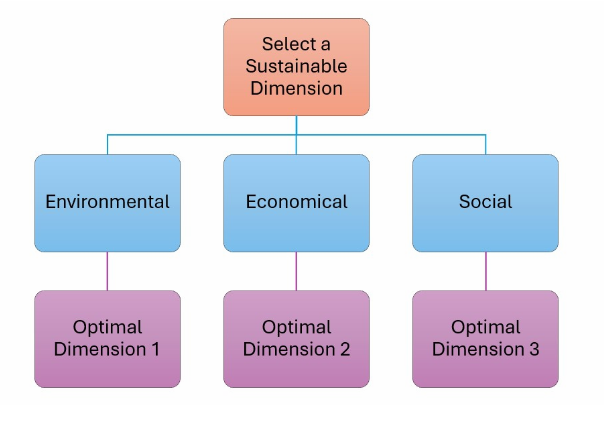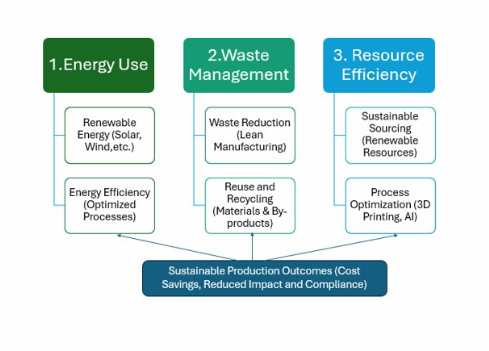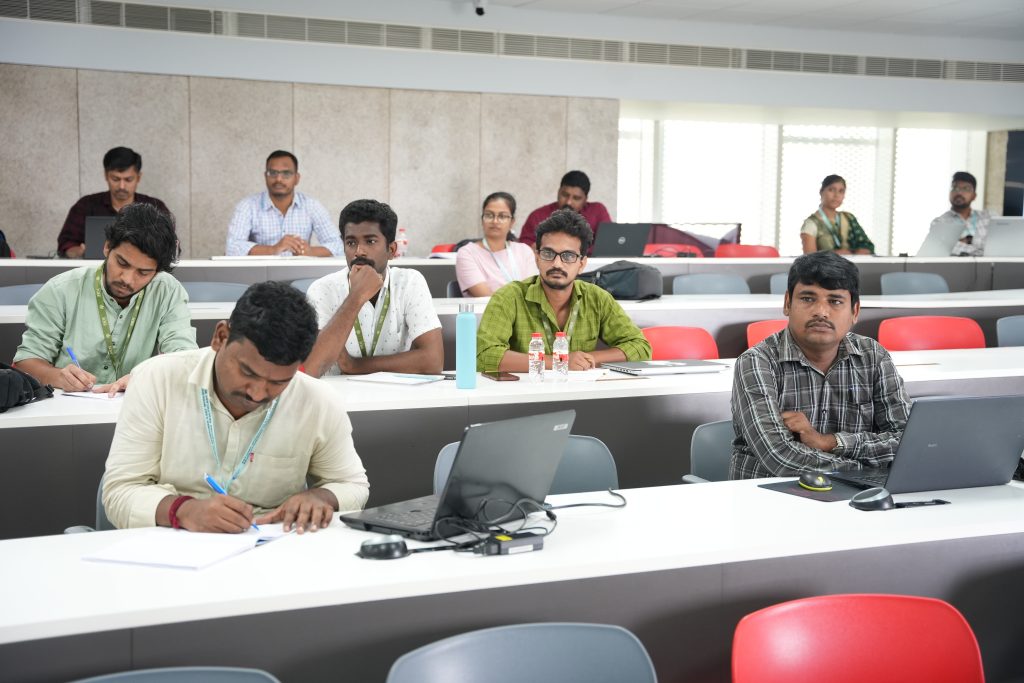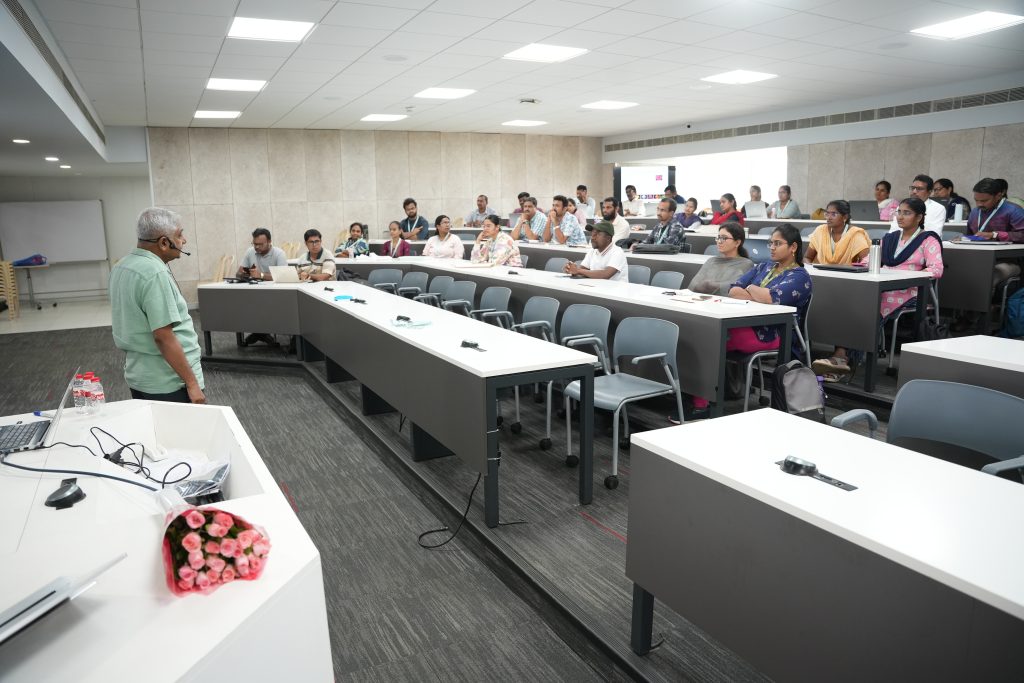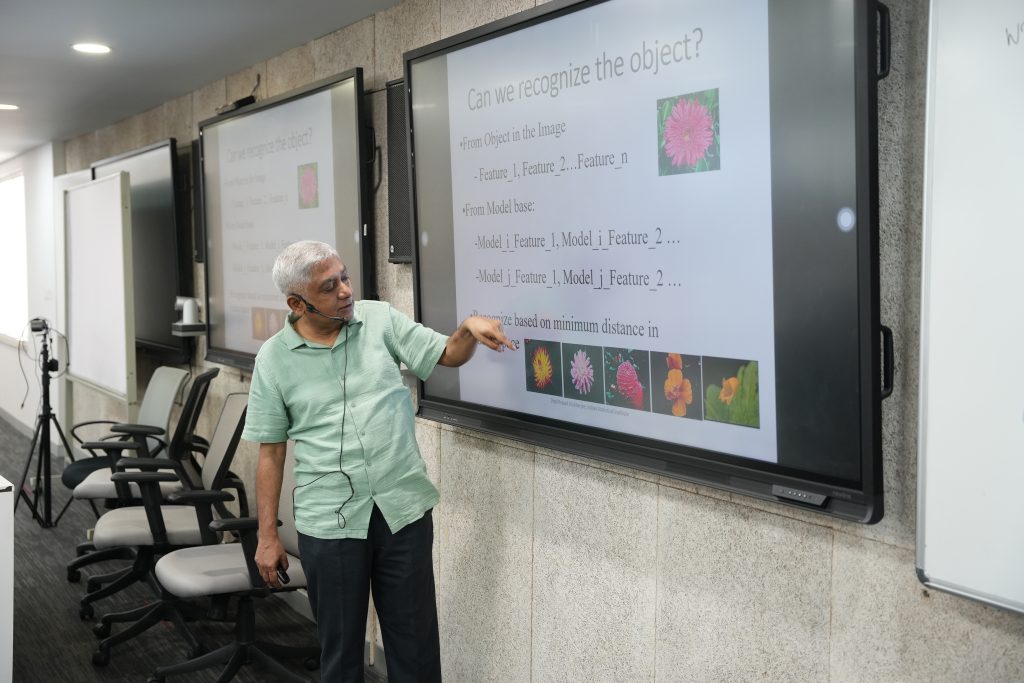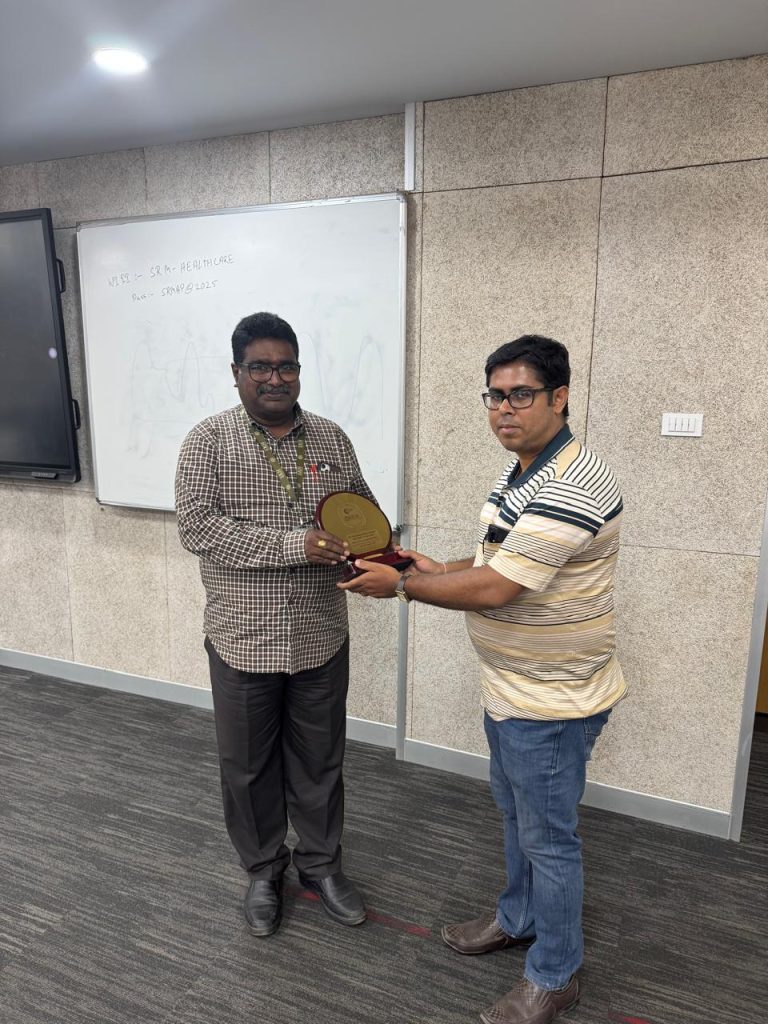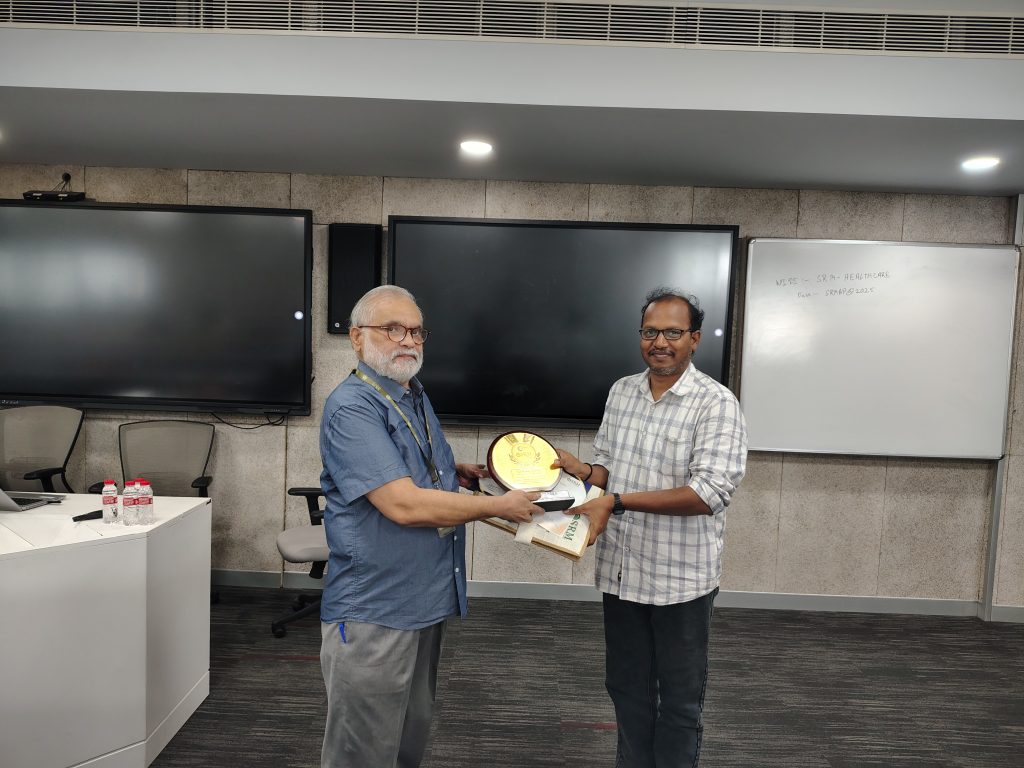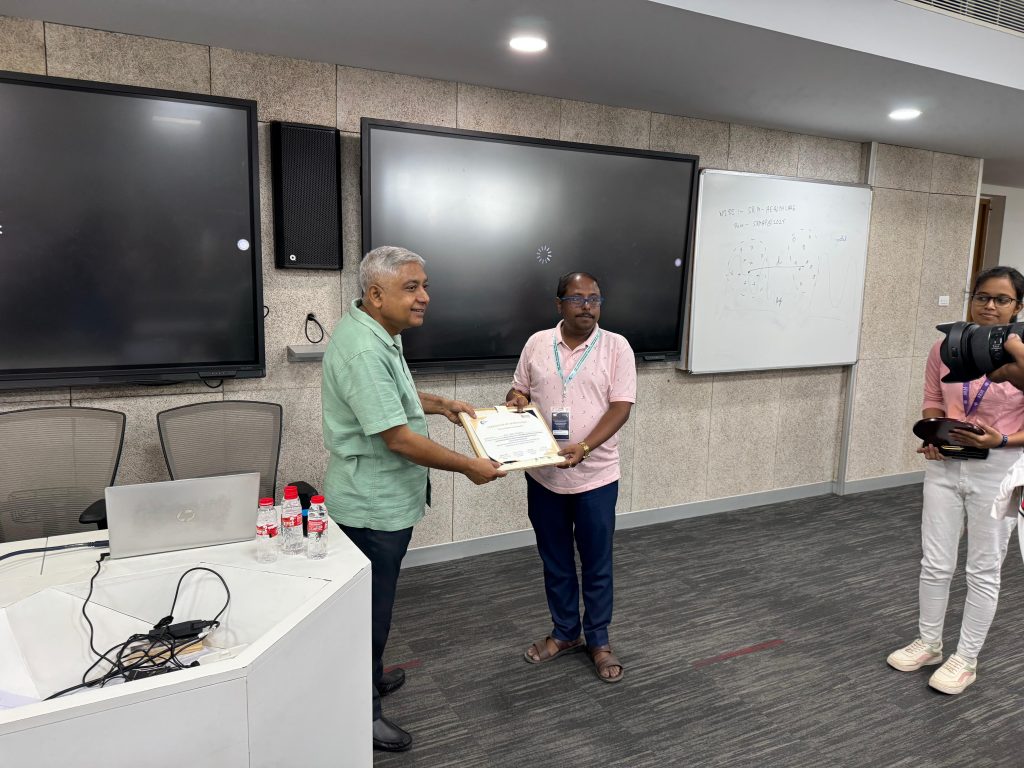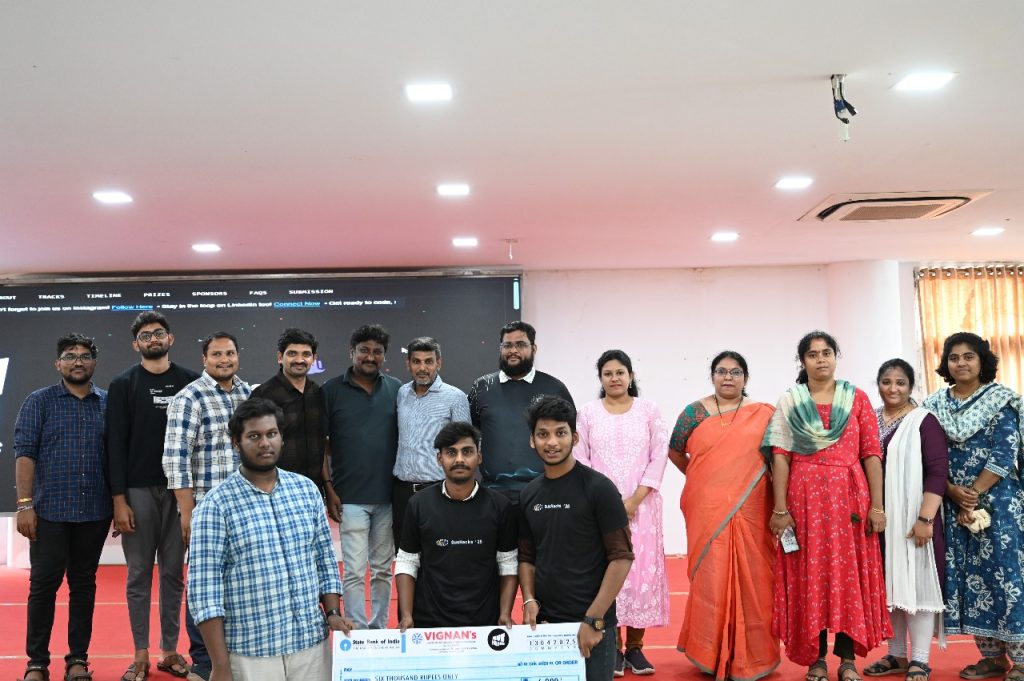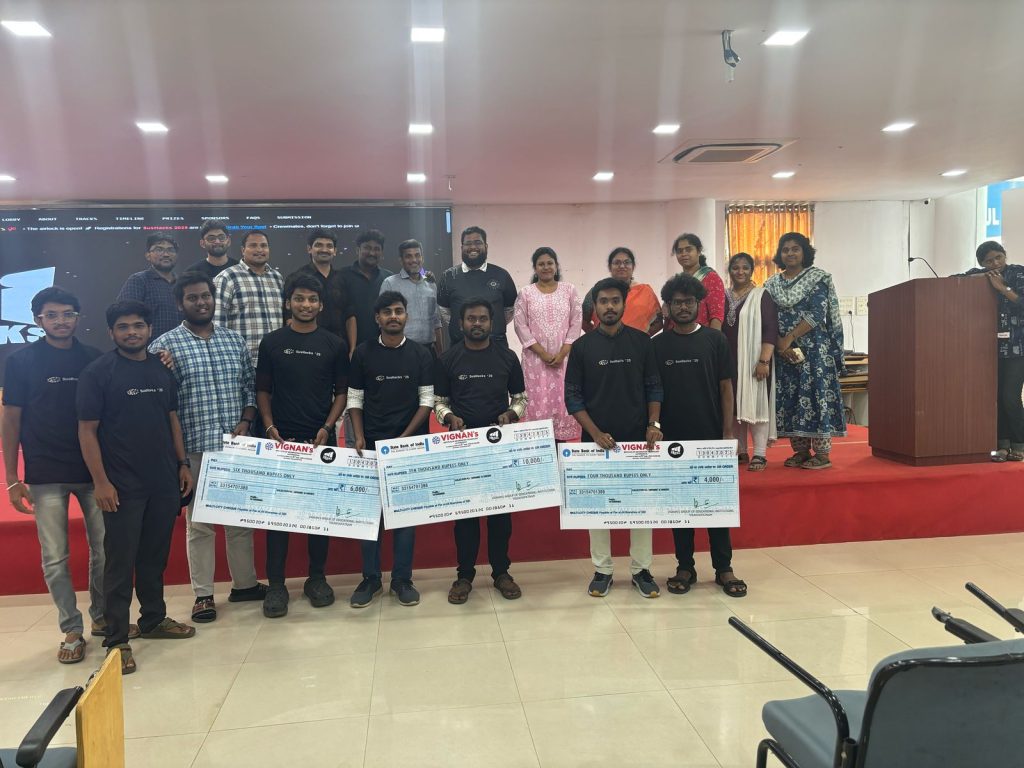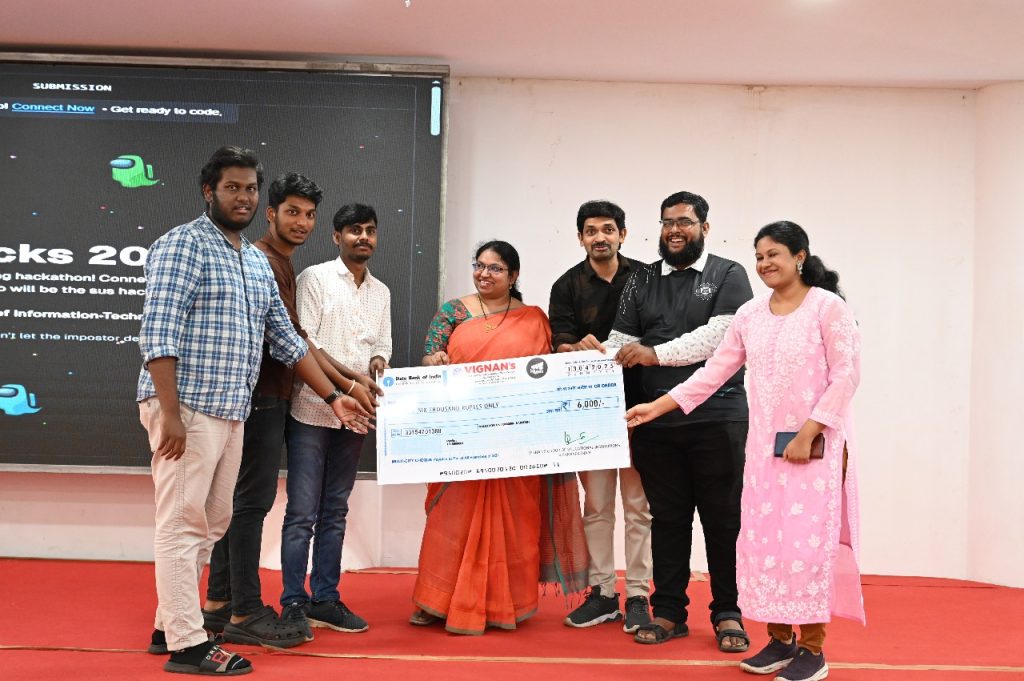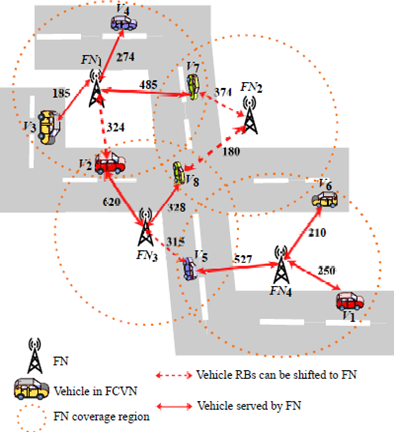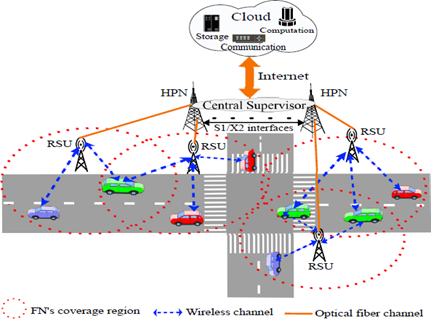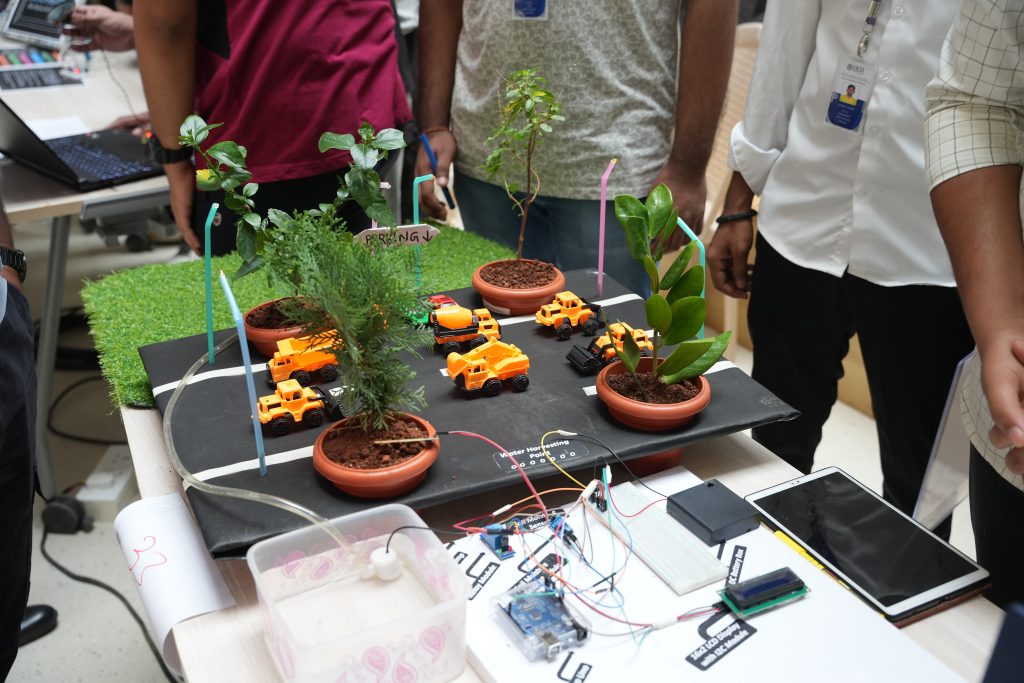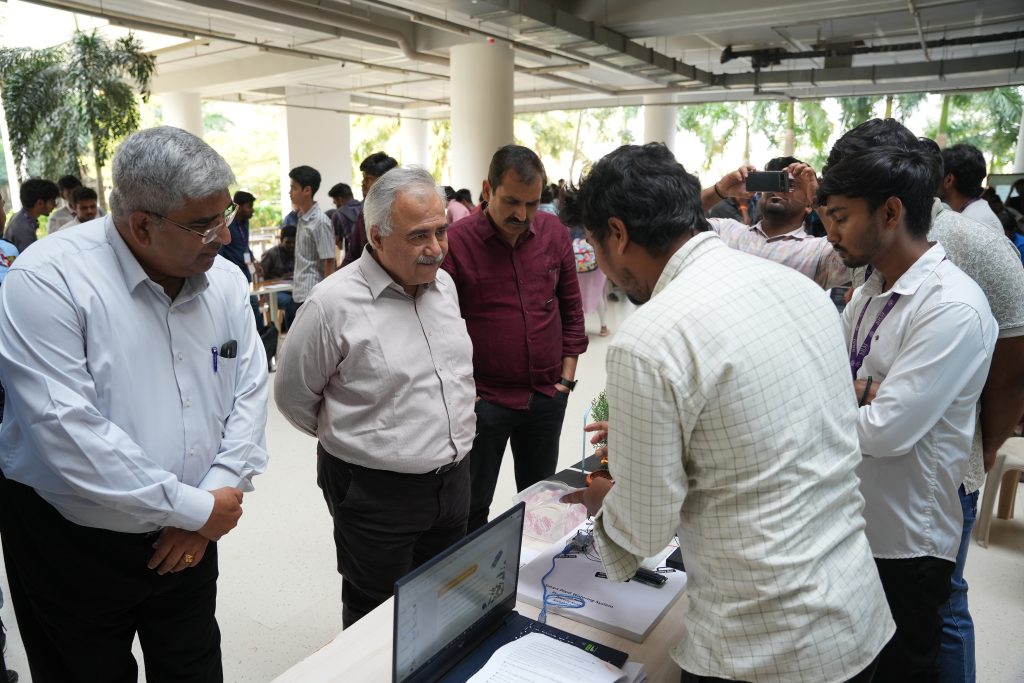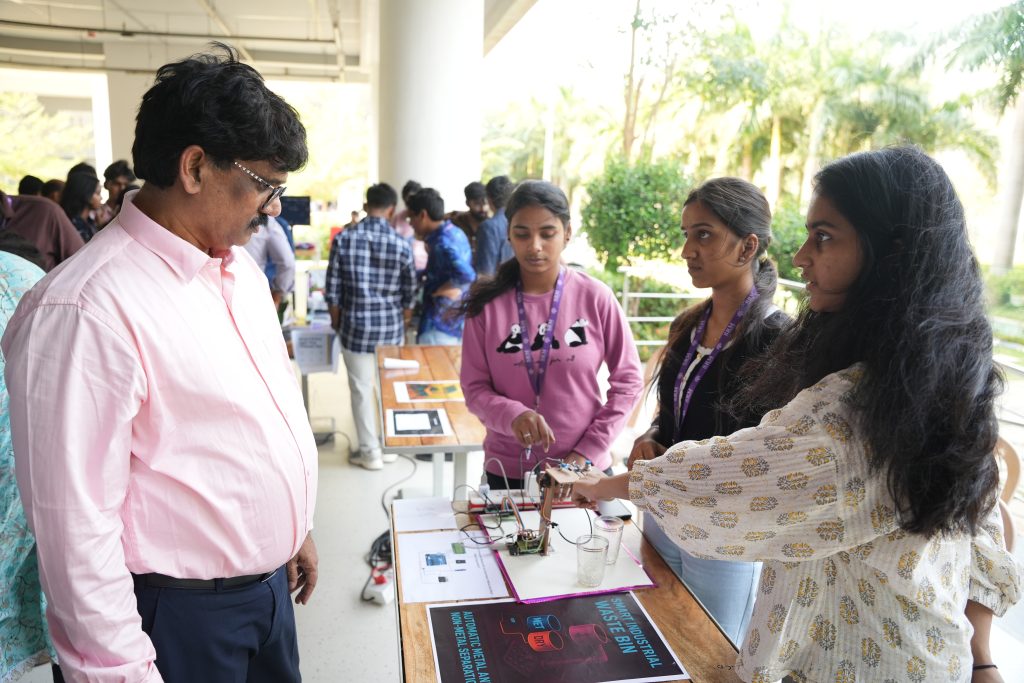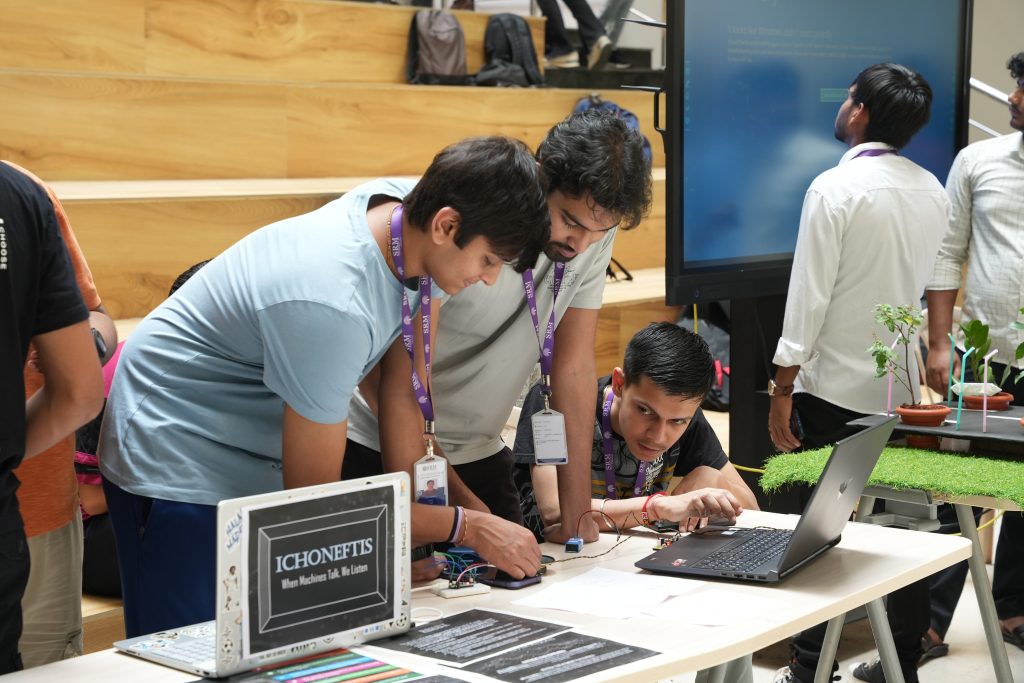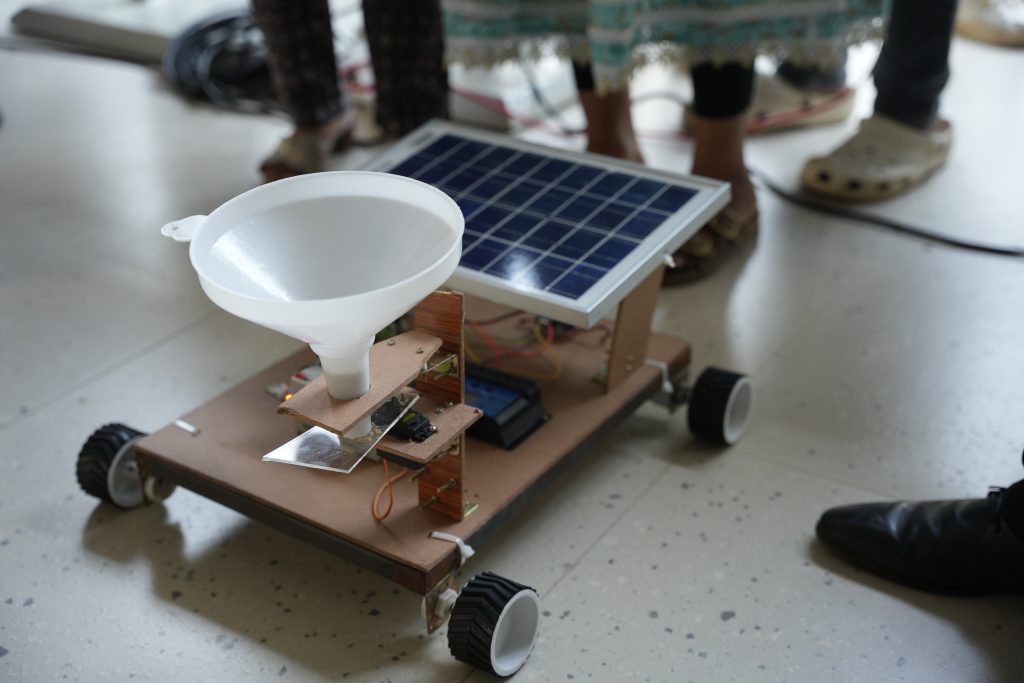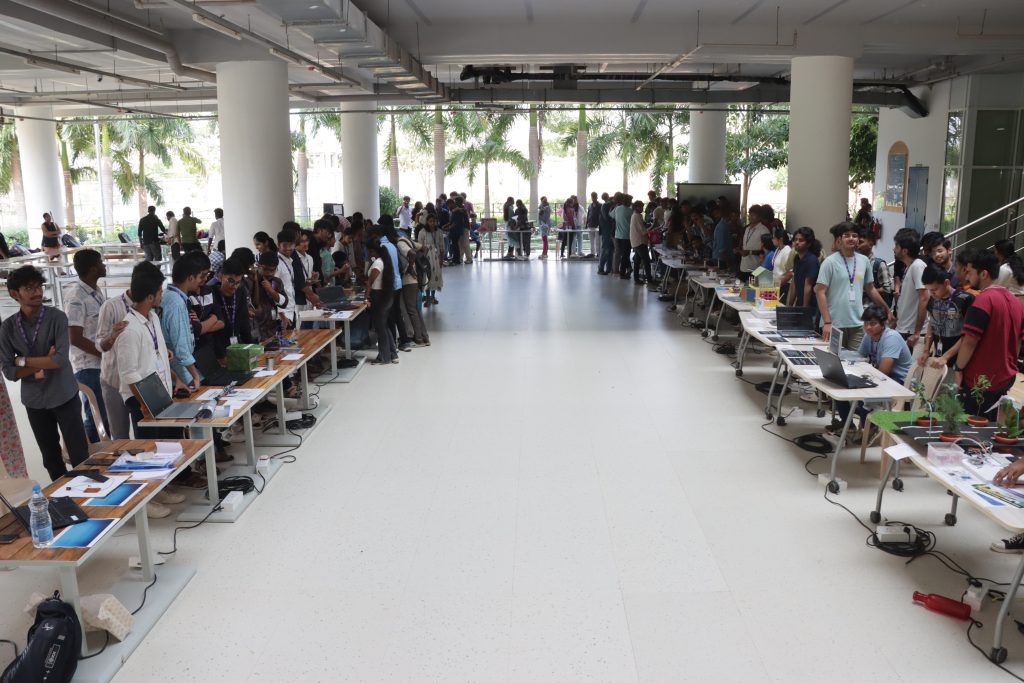Quantum-Inspired Multimodal Summarizer: A Breakthrough for the Information Age
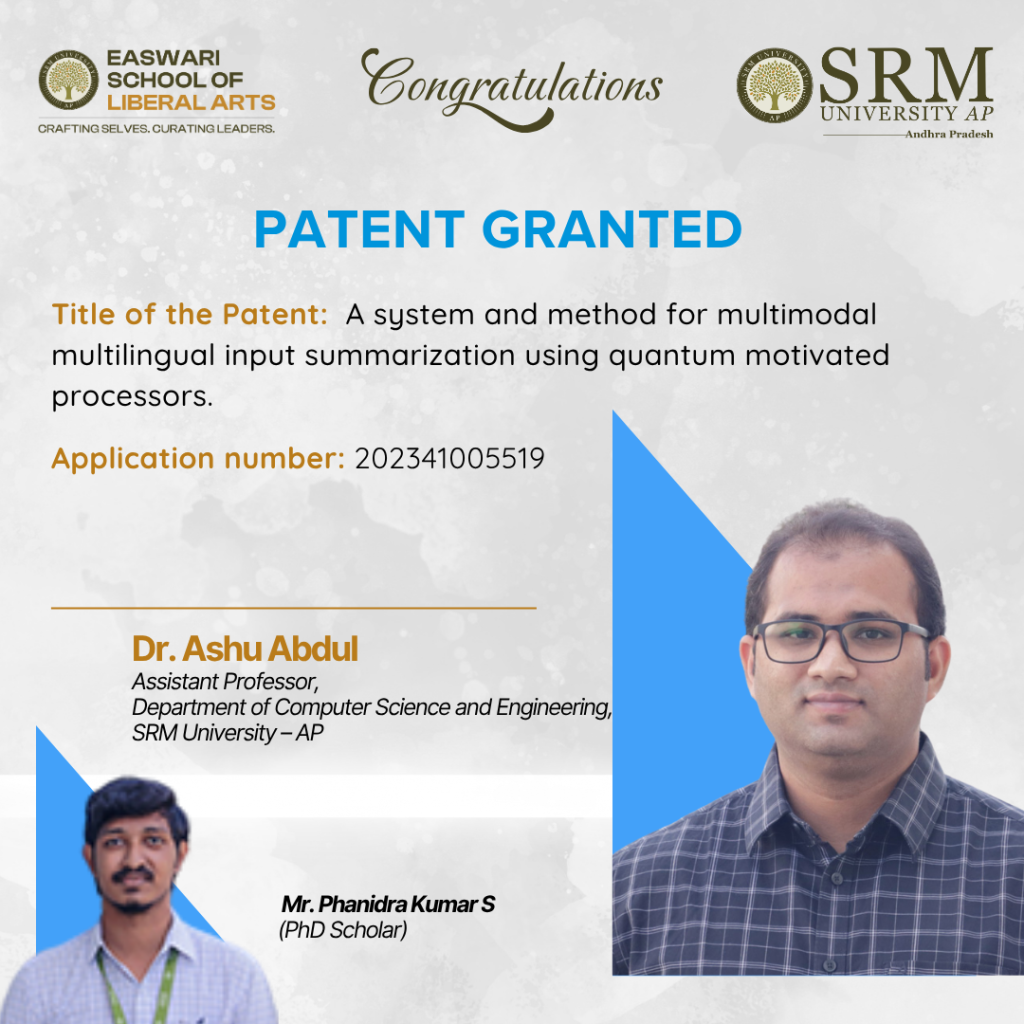
The digital age is flooded with multimedia content ranging from articles and podcasts to videos and images, spanning multiple languages. The challenge isn’t just accessing information but understanding and summarising it efficiently. Addressing this need, a pioneering patent titled “A System and Method for Multimodal Multilingual Input Summarization Using Quantum Motivated Processors” (Application Number 202341005519) has been granted to Dr Ashu Abdul, Assistant Professor in the Department of Computer Science and Engineering, and Mr Phanidra Kumar S, PhD Scholar, as published in the Indian Patent Office Journal. This innovative system converts all kinds of media like text, images, audio, and video into descriptive text, then leverages quantum-inspired algorithms to extract and stitch together the most relevant sentences and visuals, thereby crafting a perfect summary.
Abstract
This research details a system and method for summarizing multimodal and multilingual input data by leveraging quantum-motivated processors. The system is designed to handle input documents comprising text, audio, image, and video data, potentially in multiple languages. A pre-processing engine extracts textual descriptions from all these modalities (using deep learning, CNN, VAF, Python), merging them into a unified text corpus. A quantum enabler module assigns initial probabilities and encodes sentences from this corpus into binary states (0s or 1s), reflecting a quantum measurement concept (using randint). A selection module, utilizing an objective/fitness function incorporating factors like term frequency, sentence length, pronoun presence, coverage (QCSS-based similarity), and title relevance (Sentence-to-Title QCSS), calculates a fitness score for each encoded sentence and shortlists relevant ones using a “radiant function”. This module also handles duplicate removal based on QCSS. A rearrangement module scores and reorders the shortlisted sentences based on metadata (like publishing date) and scores (like ROUGE). A summary generation module produces a textual summary. Concurrently, an image selector engine selects a relevant image from the input data, primarily based on the image’s textual description and the generated summary, often using QCSS (Quantum Cosine Similarity Score). Finally, an output engine merges the textual summary with the selected image to create a multioutput (MO) summary. The system may also include a machine translation engine to translate non-English extracted descriptions into English before summarization, if needed. The approach employs quantum measurement and adaptive quantum rotation gates within an evolutionary framework (suggesting a Quantum Genetic Algorithm approach, referred to as MSQMGA) to find optimal summary sentences, demonstrating improved performance and efficiency compared to traditional Genetic Algorithms.
Practical Implementation of the Research
The system’s design outlines a modular architecture suitable for software or hardware implementation, involving distinct processing engines (Input, Pre-processing, Quantum Enabler, Selection, Rearrangement, Summary Generation, Image Selector, Output, and potentially Machine Translation). Key technical details include:
- Pre-processing: Use of Python, deep learning models (VAF, CNN) for extracting textual descriptions from audio/video/image data.
- Quantum Enabler/Selection: Assignment of initial probability (1/√2), encoding via a randomized quantum measurement model (randint(0,1) <= alpha_i), fitness function incorporating multiple weighted factors (fs = [0.75 * ((w1) * C * + w2 * pn * Ts) + 0.25 * S1] * Tf), QCSS for similarity checks (summary-to-document, sentence-to-title, intra-sentence, image selection), shortlisting via a radiant function, duplicate removal via QCSS.
- Rearrangement: Sorting shortlisted sentences based on metadata like publishing date and ROUGE score.
- Image Selection: Deep learning models like QTL-based CNN-LSTM, thresholding (e.g., 0.85).
- Multilingual Handling: Explicit mention of a Machine Translation Engine (122) to translate non-English extracted text into English
- Performance: Claims of achieving ROUGE-1 scores (e.g., 0.78) and QCSS scores (e.g., 92% for image ID), and being “quite faster” compared to traditional GA approaches.
- Datasets: Evaluation conducted using DUC 2005, DUC 2007, Indian Express datasets for text summarization, and Flickr 8k, Flickr 30k, Indian Express datasets for image description (ID).
These specifics suggest practical implementation could involve developing software modules that utilize libraries for deep learning (e.g., TensorFlow, PyTorch with CNN, LSTM components), natural language processing (e.g., NLTK, spacy for tokenization, POS, lemmatization), and potentially frameworks for simulating or interfacing with quantum-inspired algorithms. The “real-time applications” aspect implies design considerations for efficiency and processing speed. Potential deployments include news aggregation platforms, content management systems, competitive intelligence dashboards, cross-cultural communication tools, or applications for analysing vast archives of mixed-media data.
Social Impact
Beyond basic information access, this technology has the potential to foster greater understanding and reduce bias by providing summarized content across linguistic and cultural divides. It could empower individuals and organisations to consume and analyse global information landscapes more effectively. For educators, it could facilitate the creation of multimodal learning materials from diverse sources. For researchers, it could accelerate literature review across different fields and languages. However, it also raises potential implications related to the source and neutrality of the summarisation models themselves – whose perspective is encoded, and how might summaries differ based on training data or algorithmic biases? Ethical considerations around information representation and potential manipulation of summaries would be important as such technologies become more widely adopted.
Future Research Plans
Although the patent doesn’t explicitly list a roadmap, the detailed description and stated advantages imply several potential future research directions and refinements based on the current work:
- Algorithmic Refinement: Further optimizing the “quantum-motivated” genetic algorithm (MSQMGA) framework, including the fitness function weights (w1, w2 are mentioned as trainable parameters), the “radiant function” for shortlisting, and the quantum measurement mapping.
- Modality Integration: Enhancing the pre-processing and integration of information from different modalities, potentially exploring more sophisticated methods for cross-modal semantic understanding beyond extracting textual descriptions.
- Cross-Lingual Capabilities: Improving the multilingual summarization accuracy, potentially integrating more advanced machine translation techniques directly within the summarization process or extending the quantum-motivated selection mechanism to handle multi-language sentence comparisons natively.
- Quantum Hardware Exploration: Investigating the feasibility and performance benefits of implementing parts of the system, particularly the quantum enabler and selection modules, on actual quantum computing hardware as it matures, moving beyond the current “quantum-motivated” (inspired/simulated) approach.
- Scalability and Real-time Performance: Further developing the system to handle even larger volumes of multimodal, multilingual data efficiently for true real-time applications.
- Evaluation and Benchmarking: Expanding testing on a wider range of diverse datasets and benchmarking against more varied state-of-the-art multimodal and multilingual summarization techniques.
- Summarization Quality: Focusing on subjective quality metrics of the generated summaries, such as coherence, readability, and conciseness, in addition to objective metrics like ROUGE
- Image Selection Enhancement: Refining the image selection process, potentially considering factors beyond just textual description and summary similarity, such as image quality, saliency, and contextual relevance within the broader multimodal input.
- Published in CSE NEWS, Departmental News, News, Research News
Blockchain and Analytical Hierarchy Process (AHP) in food systems
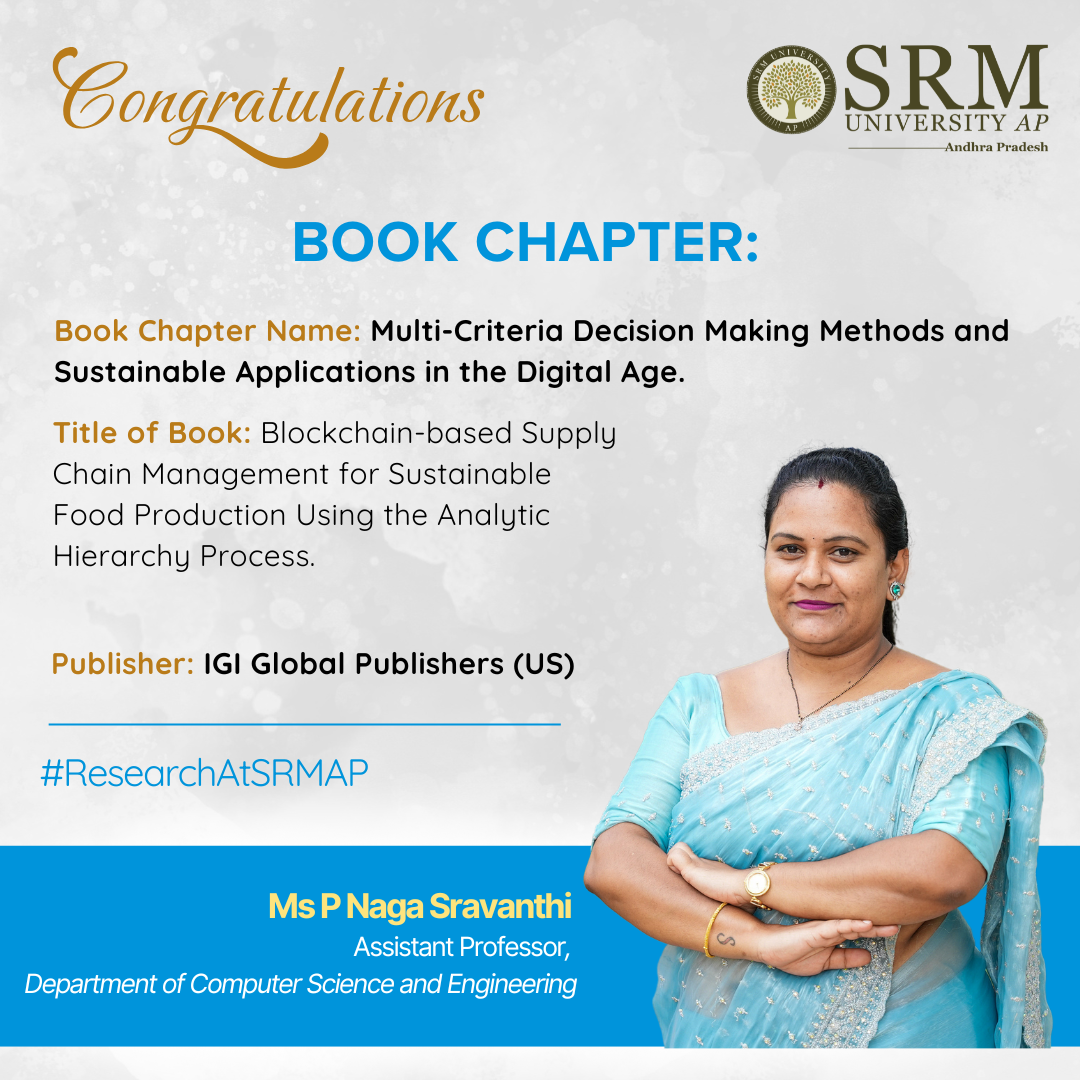 Have you ever questioned whether the food on your plate is truly fresh—or where it was grown?
Have you ever questioned whether the food on your plate is truly fresh—or where it was grown?
The efficiency of our food supply chain is often undermined by challenges such as limited traceability, poor communication, and rising labor costs. These disruptions can lead to food safety concerns, spoilage, and increased costs. Hence there’s a growing need for better tracking and transparency throughout the entire supply chain.
Addressing these issues, P Naga Sravanthi, Assistant Professor in the Department of Computer Science and Engineering, published a chapter titled “ Multi-Criteria Decision Making Methods and Sustainable Applications in the Digital Age” in the book Blockchain-based Supply Chain Management for Sustainable Food Production Using the Analytic Hierarchy Process (AHP) by IGI Global Publishers (US).
The chapter explores how blockchain can be incorporated into the food supply chain and used to track every step of the food journey. The Analytical Hierarchy Process (AHP) helps assess critical metrics like quality, cost, or environmental impact. AHP provides a transparent platform to improve food systems and make sustainable choices for all stakeholders, including farmers, sellers, and consumers.
Abstract:
This chapter discusses how blockchain technology can build transparent and trustworthy food supply chains. It combines blockchain technology with the Analytic Hierarchy Process (AHP), a structured method to rank and prioritise sustainability goals, including reducing waste, ensuring freshness, and supporting local farmers. This approach guides food producers in making smarter, eco-conscious decisions, helping them align with global sustainability goals while improving production and distribution efficiency.
Societal Impact:
This research can make a massive difference in the real-world scenario. Farmers can trace their products, suppliers can avoid fraud, and customers can get safe and fresh food. It also supports small-scale producers by giving them a voice in the supply chain. Governments and companies can use this system to ensure sustainability, reduce food loss, and build public trust in food safety and fair trade.
Future Plans :
Looking ahead, the goal is to test this blockchain-AHP model in farm-to-fork supply chains, especially in rural or emerging markets. Collaborations with agricultural cooperatives and food tech startups are in progress. Machine learning will also be integrated to improve real-time decision-making. Future research will focus on policy frameworks and community-based blockchain adoption to expand its impact on sustainable food production.
- Published in CSE NEWS, Departmental News, News, Research News
CSE Workshop on Revolutionising Health Care with AI
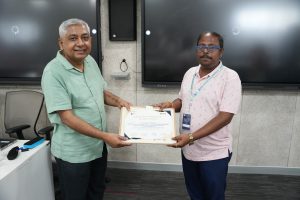 In an era when Artificial Intelligence is growing in popularity, the Department of Computer Science and Engineering decided to leverage its possibilities and expand the scope of its application across the Healthcare sector. The five-day workshop titled Revolutionising Health Care with AI: Computer Biology and Computer, sponsored by DST-ANRF, was one such event.
In an era when Artificial Intelligence is growing in popularity, the Department of Computer Science and Engineering decided to leverage its possibilities and expand the scope of its application across the Healthcare sector. The five-day workshop titled Revolutionising Health Care with AI: Computer Biology and Computer, sponsored by DST-ANRF, was one such event.
The five-day workshop explored the revolutionary potential of AI Technologies in medical diagnostics with special emphasis on the areas of Computational biology. The workshop also focused on areas of Computational Biology and Computer Vision to improve healthcare by enhancing clinical decision making and enabling personalised healthcare treatments and diagnosis.
The workshop saw the participation of academicians, research scientists and industrial experts from the fields of computer sciences, biology and data science. The workshop aimed to facilitate discussions on effectively combining computational techniques with biological research.
The workshop, apart from facilitating cross-disciplinary discussion and knowledge sharing, also laid emphasis on revisiting foundational concepts nd advancements in the areas of computer vision and machine learning. They further explored the practical implications of these concepts. The workshop also offered hands-on training opportunities to give the attendees a clear understanding of the concept and delving into areas like AI and Multiomics Data.
The participants also had the opportunity to engage in brainstorming discussions, explore innovative methods that significantly contribute to healthcare improvement, and use algorithms to enable early detection of disease. Among the notable speakers who spoke at the workshop were Prof. (Dr) Lars Kaderali from the university of University of Cologne; Dr Suvendu Rup from NIT Raipur, Prof. (Dr) Amlan Chakrabarti from the A K Choudhury School of Information Technology at the University of Calcutta and an Adjunct Professor at IIIT Delhi and Prof. (Dr) Ram Bilas Pachori among others. Their insights and expertise offered participants a thought-provoking five-day workshop that would meaningfully benefit the field of Healthcare, paving the way for innovative tools and methods that will enhance patient care.
- Published in CSE NEWS, Departmental News, News
SRM-ites Shine at National Hackathon and Startup Event
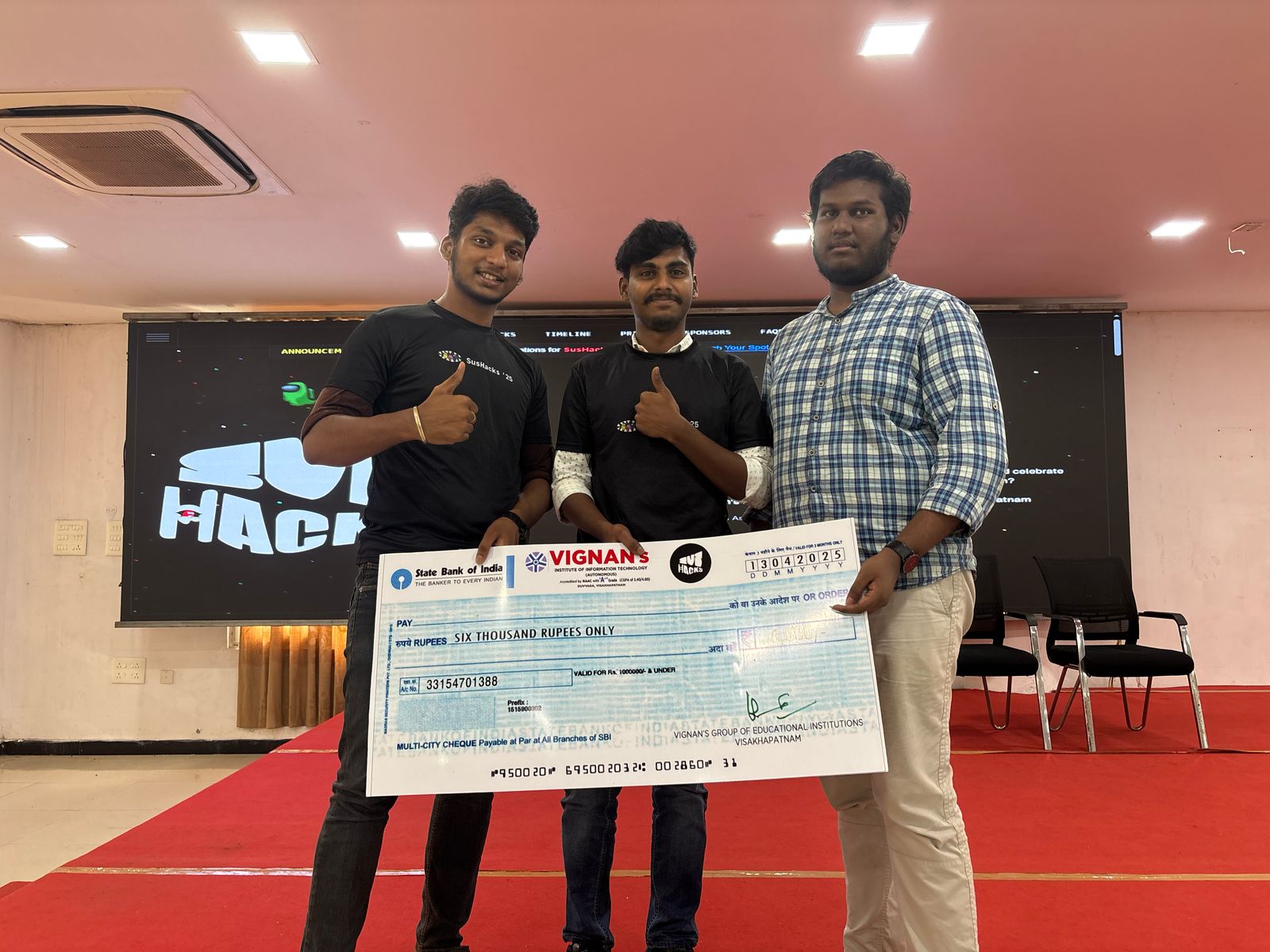 In a world where identity thefts and fraudulence cases are on the rise, our BTech- CSE students have come up with a groundbreaking idea that has not only made us all proud but has also enabled a secure platform for such transactions. Meet Pagadala Hemanth Krishna Vardhan, Uday Venkat and Pramodh Janna, SRM AP champions who have made a mark at the technical front through their innovative victory at the national-level SUS Hackathon organised by Vignan’s Institute of Information Technology, (VIIT) Visakhapatnam.
In a world where identity thefts and fraudulence cases are on the rise, our BTech- CSE students have come up with a groundbreaking idea that has not only made us all proud but has also enabled a secure platform for such transactions. Meet Pagadala Hemanth Krishna Vardhan, Uday Venkat and Pramodh Janna, SRM AP champions who have made a mark at the technical front through their innovative victory at the national-level SUS Hackathon organised by Vignan’s Institute of Information Technology, (VIIT) Visakhapatnam.
The SUS Hackathon by VIIT, Vishakapatnam, featured over 700 participants and more than 250 teams from across India. SRM AP’s project on a Decentralised Identity Management (DID) system outshone the other projects for its innovative solution, which leverages blockchain technology to grant users full control over their digital identities.
The DID system allows individuals to securely manage and share their credentials without the need for centralised authorities. This approach prioritises privacy, security, and trust—elements that are especially critical in today’s digital-first world. Speaking of their project the students stated,” We were motivated by the increasing need for secure and user-controlled digital identity systems. Our goal was to create a platform that puts identity back into the hands of individuals, reducing the risk of identity theft, surveillance, and data breaches. This drove us to innovate and push beyond conventional solutions.”
The event also offered a platform for the students to showcase their startup ideas, wherein Pagadala Hemanth Krishna Vardhan presented his idea on Virtual Hyper Accuracy of Social Services and received wide attention from mentors and jury members. This start-up idea focuses on real-time women’s safety using voice commands, live tracking, saviour networks, and automated alert systems. The model was recognised for its practical impact and was encouraged for further development and incubation.
Platforms such as these allow our students to showcase their technical and leadership abilities, fostering a culture of innovation, collaboration, and real-world problem-solving.
- Published in CSE NEWS, Departmental News, News
Research Paper on Efficient Resource Orchestration Algorithm
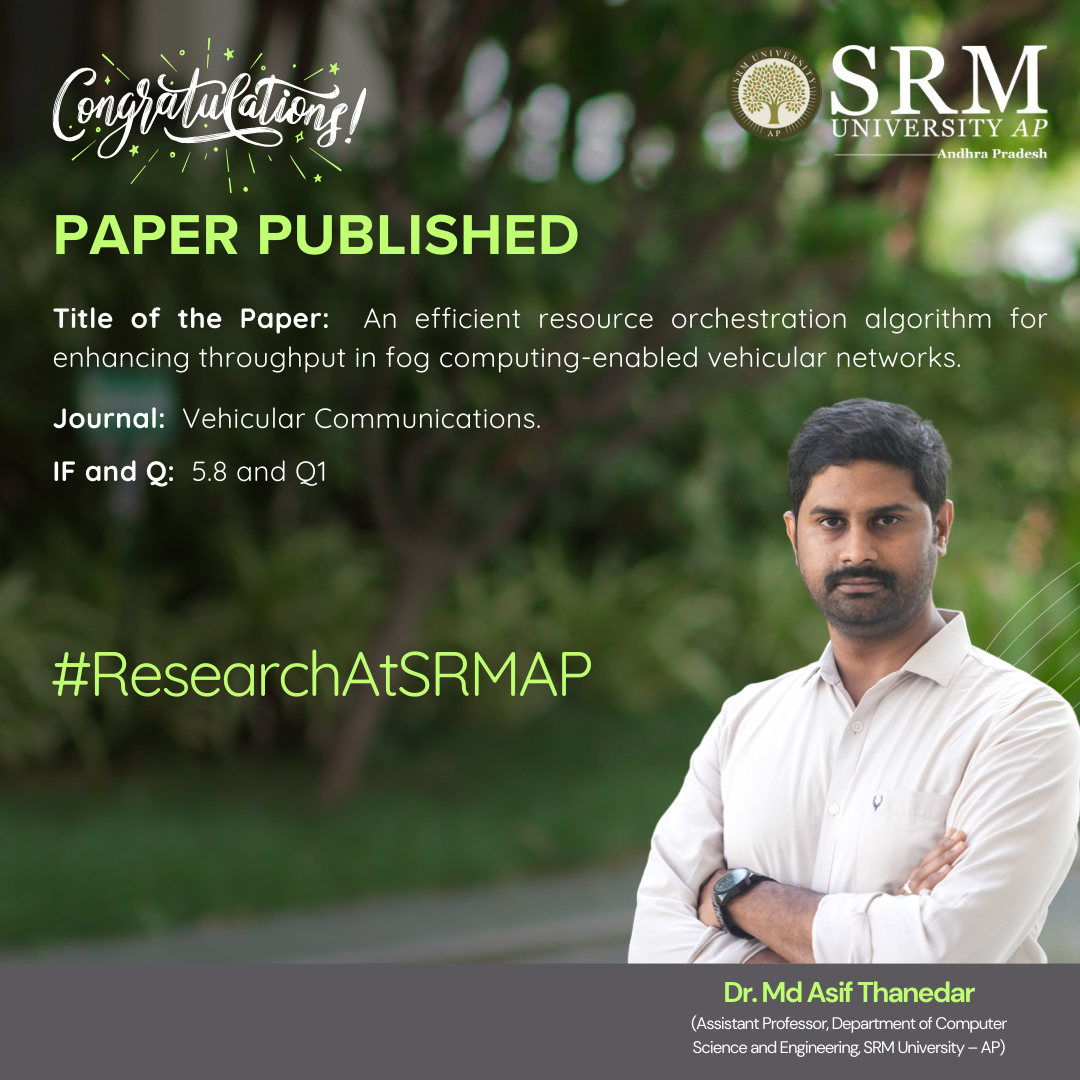 Dr Asif Thanedar, Assitant Professor at the Department of Computer Science and Engineering in research titled “An Efficient Resource Orchestration Algorithm for Enhancing Throughput in Fog Computing-enabled Vehicular Networks,” discusses issues faced by fog nodes (FNs) when serving connected vehicles during busy times. The research introduces an Efficient Resource Orchestration (ERO) algorithm designed to improve network performance by optimising resource use within the limits of FNs. The study aims to make a valuable contribution to the fields of vehicular fog computing and resource management.
Dr Asif Thanedar, Assitant Professor at the Department of Computer Science and Engineering in research titled “An Efficient Resource Orchestration Algorithm for Enhancing Throughput in Fog Computing-enabled Vehicular Networks,” discusses issues faced by fog nodes (FNs) when serving connected vehicles during busy times. The research introduces an Efficient Resource Orchestration (ERO) algorithm designed to improve network performance by optimising resource use within the limits of FNs. The study aims to make a valuable contribution to the fields of vehicular fog computing and resource management.
Abstract :
The intelligent vehicles are connected to the roadside infrastructure, such as high power nodes (HPNs) and roadside units (RSUs), also called fog nodes (FNs), for obtaining on-demand services. These FNs possess finite resources and can provide services to limited vehicles. However, when vehicles reach the network spike in demand, the FNs become impuissant in furnishing services in the existing solutions. As a result, there is a significant reduction in the network throughput. Therefore, we propose an efficient resource orchestration (ERO) algorithm to maximize the throughput by reducing the allocated resource blocks (RBs) of FNs.
Explanation in layperson’s terms:
The throughput is maximized by migrating allotted RBs of vehicles in non-restricted coverage regions such that the allotted RBs of these vehicles are minimized among pairs of FNs.
We formulated the RBs migration problem in FCVNs to an integer linear programming (ILP) by scrutinizing the variables influencing the network throughput and FNs resource constraints.
We propose an ERO algorithm, a polynomial time algorithm, which constructs the minimum priority queue for optimal RBs migration between pairs of FNs to augment the network’s throughput. The ERO algorithm synchronizes the RBs allocation for offloading upstream services such that throughput is maximized by partitioning the coverage of FNs into restricted and non-restricted coverage regions.
Practical implementation:
For practical implementation we consider the FNs are equipped with large batteries and deployed across the highway segments of remote areas (i.e., forests or hill terrain) with no consistent power supply. In this context, we present an efficient resource orchestration (ERO) algorithm for harmonizing RB allocation and offloading upstream services among FNs to maximize the network throughput during battery depletion.
Collaborations:
Dr Sanjaya Kumar Panda, Assistant Professor, Dept. of CSE, National Institute of Technology Warangal.
Future Research Plans:
Resource Provisioning in Fog environment.
Energy Efficiency in vehicular fog computing (VFC).
Multi-objective optimization in fog computing.
- Published in CSE NEWS, Departmental News, News
Dr Priyanka Singh and Students Collaborate on Innovative Approach of Image Retrieval
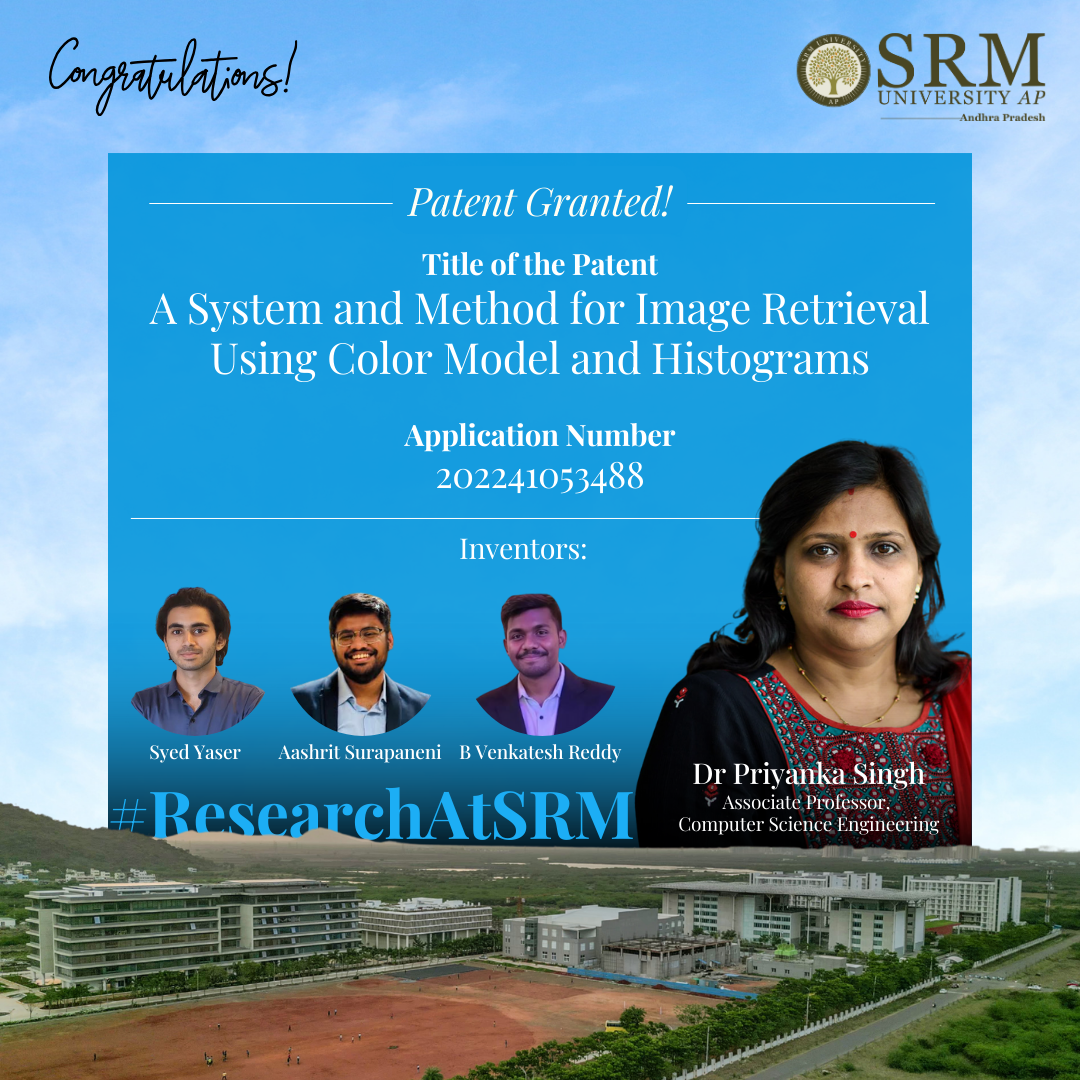 The patent titled “A System and Method for Image Retrieval Using Color Model and Histograms“, with application number 202241053488, presents a novel approach to image retrieval. Authored by Syed Yaser, Sai Aashrit Surapaneni, and B Venkatesh Reddy, with guidance from Dr Priyanka Singh, Associate Professor, Department of Computer Science and Engineering, this work explores the efficient and effective retrieval of images from large databases. The findings contribute significantly to advancements in various fields, including medical imaging and digital libraries.
The patent titled “A System and Method for Image Retrieval Using Color Model and Histograms“, with application number 202241053488, presents a novel approach to image retrieval. Authored by Syed Yaser, Sai Aashrit Surapaneni, and B Venkatesh Reddy, with guidance from Dr Priyanka Singh, Associate Professor, Department of Computer Science and Engineering, this work explores the efficient and effective retrieval of images from large databases. The findings contribute significantly to advancements in various fields, including medical imaging and digital libraries.
Abstract:
Content Based Image Retrieval; a widely researched area in the past few decades when it comes to image retrieval and searching images in a large database. The proposed scheme is based on Hue, Saturation, Value (HSV) components of an image and compares images by calculating the distance between histograms is used to implement CBIR using global and local comparison. Histogram of hue and saturation is generated for global comparison. The image in the database which has the minimum distance to our query image is the most similar image of all images. Which means when the distance is 0 the query image is the same as the target image which concludes the image retrieval process. The above algorithm has been completely implemented using python. Python was chosen because of its inbuilt libraries like cv2 for image processing, numpy for mathematical calculations and matplotlib for visualisation
Practical Implementation:
The system can be applied in various fields like medical imaging, digital libraries, surveillance, and e-commerce platforms where quick and accurate image search is necessary. It can also enhance accessibility tools for the visually impaired by recognising images based on content.
Collaborations:
This project was done with the support and guidance of professors and fellow students from the Department of Computer Science and Engineering at SRM University AP, Amaravati. The main team from SRM included:
Syed Yaser
Sai Aashrit Surapaneni
B Venkatesh Reddy
Dr Priyanka
Dr Naushad Varish from Koneru Lakshmaiah Education Foundation, Guntur, also made significant contributions to the work.
- Published in CSE NEWS, Departmental News, News, Research News
SRM-ites Shine at the TechXcelerate Hackathon
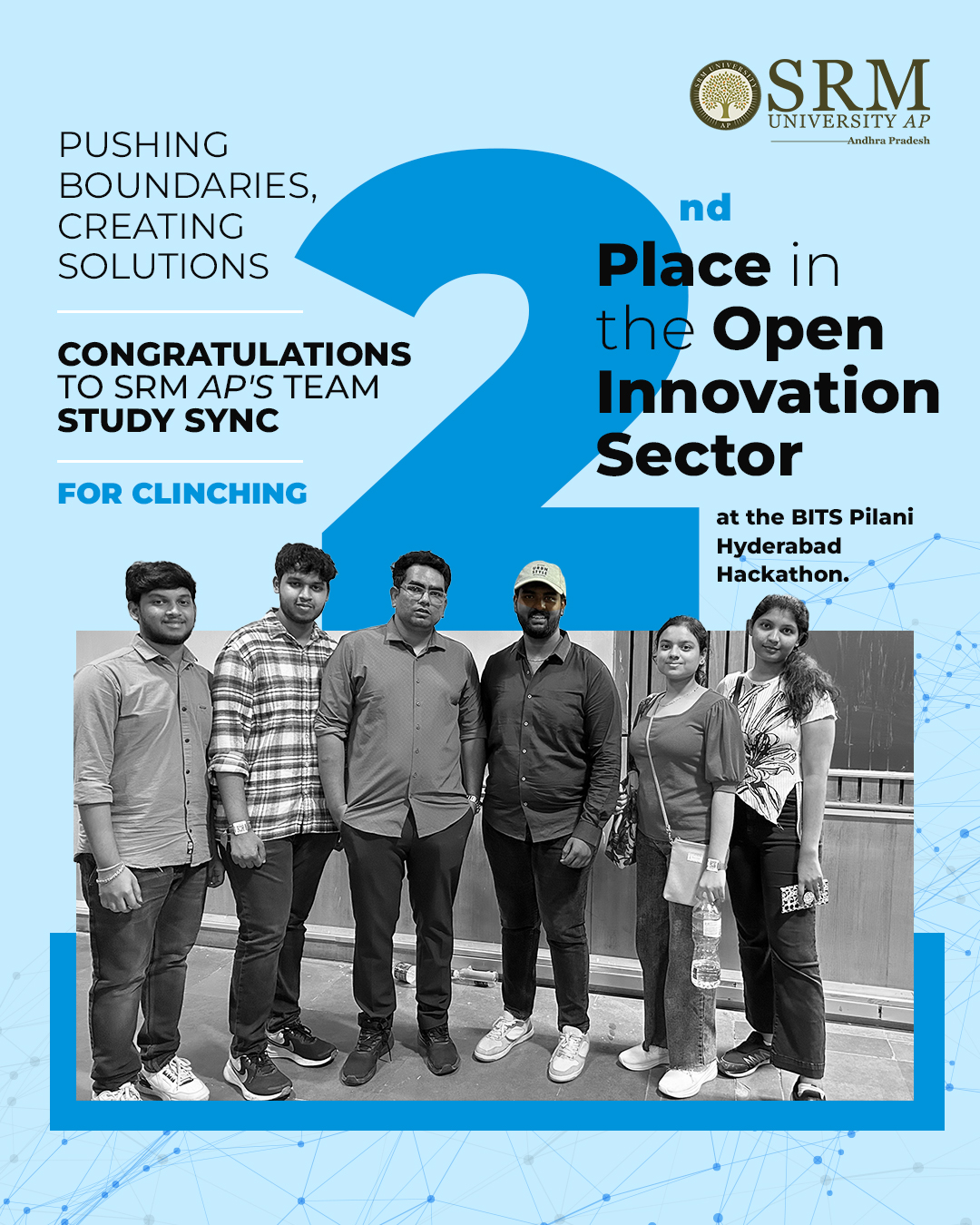 We are delighted to share the outstanding achievement of our students from the Department of Computer Science and Engineering, SRM University-AP, who have secured the Second Position in the prestigious TechXcelerate Hackathon conducted by BITS Pilani, Hyderabad Campus from March 22 to 24, 2025.
We are delighted to share the outstanding achievement of our students from the Department of Computer Science and Engineering, SRM University-AP, who have secured the Second Position in the prestigious TechXcelerate Hackathon conducted by BITS Pilani, Hyderabad Campus from March 22 to 24, 2025.
The winning team comprised five talented students from the Department of Computer Science and Engineering: G. Dhanush, K. Venkat, P Bhavya Sri, K Vaishnavi, and Jogith.
Competing in the Open Innovation Track of this national-level event, the team, StudySync, demonstrated exceptional creativity, technical expertise, and innovative problem-solving skills amidst participation from over 4000+ students and 829+ teams across India. The team also participated in the TechXcelerate Program, an innovation accelerator initiative, and was conferred the Hackathon Codebeta recognition by Barathversity.
The team developed StudySync, a next-generation collaborative productivity platform tailored for students. The platform enhances academic engagement through smart scheduling, intuitive task tracking, and interactive study rooms, creating an efficient learning environment.
This remarkable achievement is a testament to the innovative spirit and technical brilliance of our students. The university congratulates Team StudySync on their well-deserved success and wishes them the very best in their future endeavours.
- Published in CSE NEWS, Departmental News, News, Students Achievements
Innovations from the Future: CSE Students Showcase Tech Projects
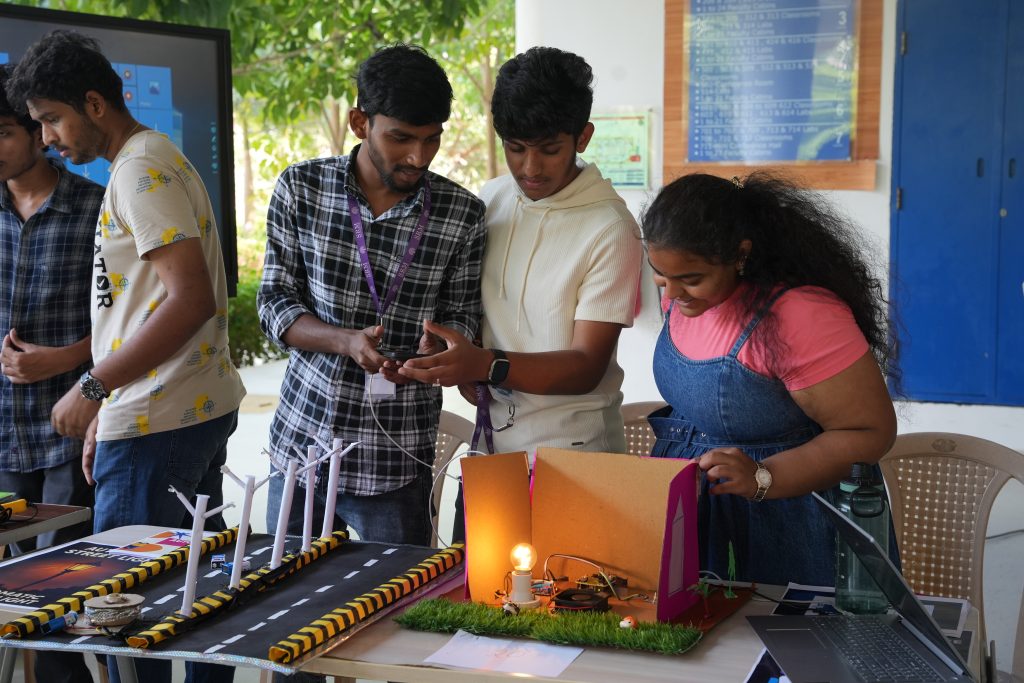
As part of the project-based learning initiative, Dr Tousif Khan from The Department of Electrical and Electronics Engineering organised a Project Exhibition titled “Redefining Boundaries in Technical Learning” for the 2025 batch (CSE-J and CSE-K sections). 120 first-year B.Tech students, organised into 40 groups, showcased their talent and creativity through a series of innovative tech projects aimed at solving real-world problems with smart solutions.
Some of the notable tech demonstrations were:-
- Hand Gesture Controlled Surveillance Car – Used motion sensors to respond to hand commands offering a futuristic approach to remote-controlled security.
- SenseFusion – A mobility aid designed specifically for individuals who are both blind and deaf, combining sensors to provide better spatial awareness and safety.
- The Wireless Power Transmission Device – Eliminating the need for physical cables – an eco-friendly leap toward efficient energy use.
- Smart Plant Watering System – Used soil moisture sensors to automatically hydrate plants, promoting sustainable agriculture with minimal human intervention.
- Solar Tracker – Followed sunlight throughout the day to optimise energy capture
- Automatic Wind Power Street Light – Converted wind energy into reliable, self-sufficient lighting.
- EM Wave Detector – Used CA3130 by detecting unauthorised mobile devices, ideal for ensuring exam hall integrity.
These projects not only reflect technical skill and creativity but also highlight the SRM AP students’ commitment to building a smarter, safer, and more sustainable future. The showcase was a proud testament to the emphasis on experiential learning and innovation brewing within the halls of SRM AP.
- Published in CSE NEWS, Departmental News, EEE NEWS, News
CSE Professors Research on Automated Agricultural Spraying
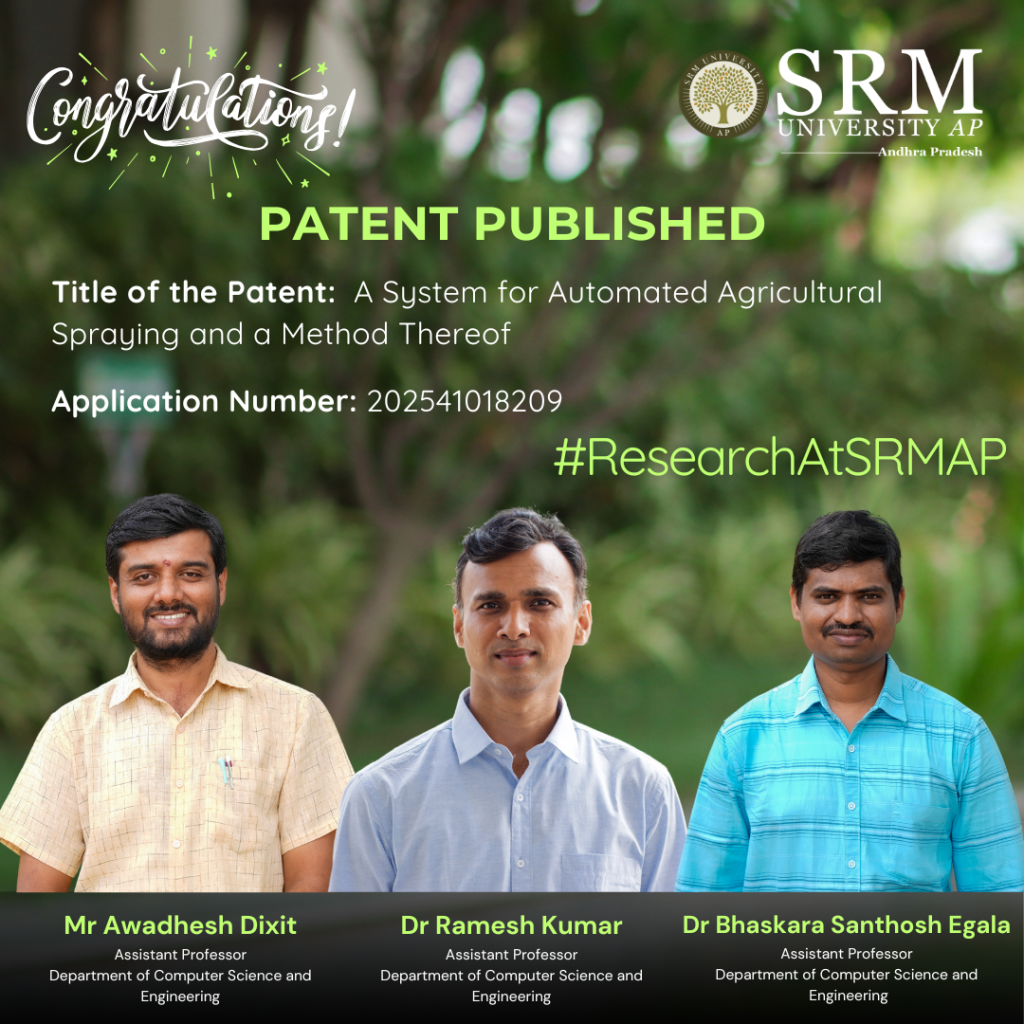 This research, titled “A System for Automated Agricultural Spraying and a Method Thereof,” focuses on developing a coordinated multi-UAV framework for precision agricultural spraying. Led by Dr Awadhesh Dixit and his faculty team, Dr Ramesh Kumar, and Dr Bhaskara Santosh Egala, Assistant Professors at the Department of Computer Science and Engineering, this innovative research enhances efficiency in crop management by utilising advanced technologies for real-time data integration and optimisation.
This research, titled “A System for Automated Agricultural Spraying and a Method Thereof,” focuses on developing a coordinated multi-UAV framework for precision agricultural spraying. Led by Dr Awadhesh Dixit and his faculty team, Dr Ramesh Kumar, and Dr Bhaskara Santosh Egala, Assistant Professors at the Department of Computer Science and Engineering, this innovative research enhances efficiency in crop management by utilising advanced technologies for real-time data integration and optimisation.
Abstract
This invention presents a novel system and process for precision agricultural spraying using a coordinated multi-UAV (Unmanned Aerial Vehicle) framework. The system integrates multiple UAVs equipped with sensors (e.g., LiDAR, ultrasonic) and spraying mechanisms, managed by a central control unit employing hybrid approach combining PSO, Fuzzy Logic, and Reinforcement Learning (RL) for efficient real-time multi-UAV coordination. The hybrid system dynamically adapts to environmental conditions, ensuring optimal path planning, collision avoidance, and spray adjustments. The process involves real-time data collection on crop density, environmental conditions, and obstacles, enabling dynamic flight path planning and adaptive spray rate adjustments. Key innovations include the use of advanced control software for UAV coordination, obstacle avoidance, and uniform pesticide application, combined with hardware featuring adjustable spraying devices. This approach enhances efficiency, reduces collision risks, and ensures precise coverage in complex agricultural environments, distinguishing it from prior UAV-based spraying systems through its sophisticated integration of real-time optimization and multi-UAV collaboration.
Explanation in layperson’s terms
Imagine a team of small flying robots (drones) working together to spray crops on a farm. First, they use their cameras and sensors to check the fields, figure out where the bugs or weeds are, and spot anything in the way, like trees or fences. Then, they plan the best paths to fly so they don’t crash and can cover everything evenly. Each drone has a sprayer that can change how much it sprays depending on what the crops need—like giving extra spray where there are more bugs. A smart computer program helps them talk to each other and decide what to do as they go. This makes farming easier, faster, and wastes less spray compared to older ways.
We have created a way to use drones to spray crops with bug-killing chemicals more smartly. One drone checks the fields first to spot where the bugs are worst. Then, other drones with special sprayers fly over and target those spots, spraying two rows at once to save time. If they find a really buggy area, they hover there longer to make sure it’s fully covered. The drones communicate and coordinate to each other and dodge trees or other obstacles, so farmers don’t have to do it all by hand.
The hybrid system operates by continuously integrating PSO, Fuzzy Logic, and RL during UAV operations to achieve optimal coordination and performance. First, one part of the system—think of it like a master planner—figures out the best paths for the drones to fly based on what the farm looks like, like where the crops are and what’s in their way. Then, another part acts like a quick fixer—it tweaks those paths on the fly if something unexpected pops up, like thicker crops or a tree the drones didn’t see at first. It also adjusts how much spray the drones use so they don’t overdo it. Finally, there’s a learning part that helps the drones get better over time—like they remember what worked before and adapt to changes, such as growing plants or windy days. Together, this makes the drones super-efficient: they don’t bump into each other, they spray just the right amount, and they keep figuring out the best way to handle whatever the farm throws at them—all on their own.
Practical Implementation of the Research
A. Test Environment and UAVs
Field Setup:
Location: A 100-acre test field with varying crop densities (rice, wheat, and maize) and obstacles such as trees, irrigation systems, and terrain elevations.
Environmental Conditions: Tested under different weather conditions (sunny, windy, and overcast).
UAV Model:
Five multi-rotor UAVs equipped with spraying equipment, GPS, LIDAR sensors for obstacle detection, and onboard processing units to run the hybrid optimization algorithms.
Battery Life: 30-minute flight time with a 5kg payload capacity.
Communication: UAVs communicate via a wireless mesh network with a ground control system for real-time adjustments.
Each drone would also have a dual-spray setup—two adjustable nozzles attached to a tank holding pesticide or fertilizer, capable of spraying two rows of crops at once.
B. Hybrid Optimisation Algorithm
PSO for Path Planning:
Determines the optimal flight path based on crop density, UAV location, and environmental data.
Fuzzy Logic for Spray Adjustment:
Dynamically adjusts the spray level based on crop health data, wind speed, and UAV altitude.
Reinforcement Learning for Collision Avoidance:
UAVs learn from previous flight paths and environmental feedback to avoid collisions with other UAVs and obstacles.
Future Research Plans
Their future research focuses on developing swarm-based D2X communication and coordination, task rescheduling, localization, and optimized path planning to enhance UAV network performance, prevent collisions, and advance AI-related applications.
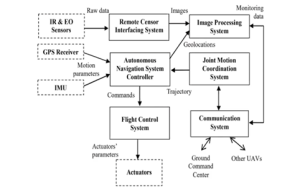
Figure 1: Block diagram of Multi-UAV Coordination path planning and coordination among multiple UAVs in an agricultural field.
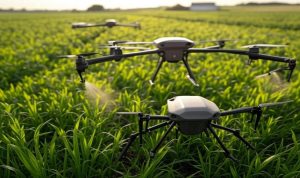
Figure 2: Diagram illustrating drone spraying in agriculture field with obstacle avoidance
- Published in CSE NEWS, Departmental News, News, Research News
Predicting Network Traffic in Next-Generation Cellular Networks
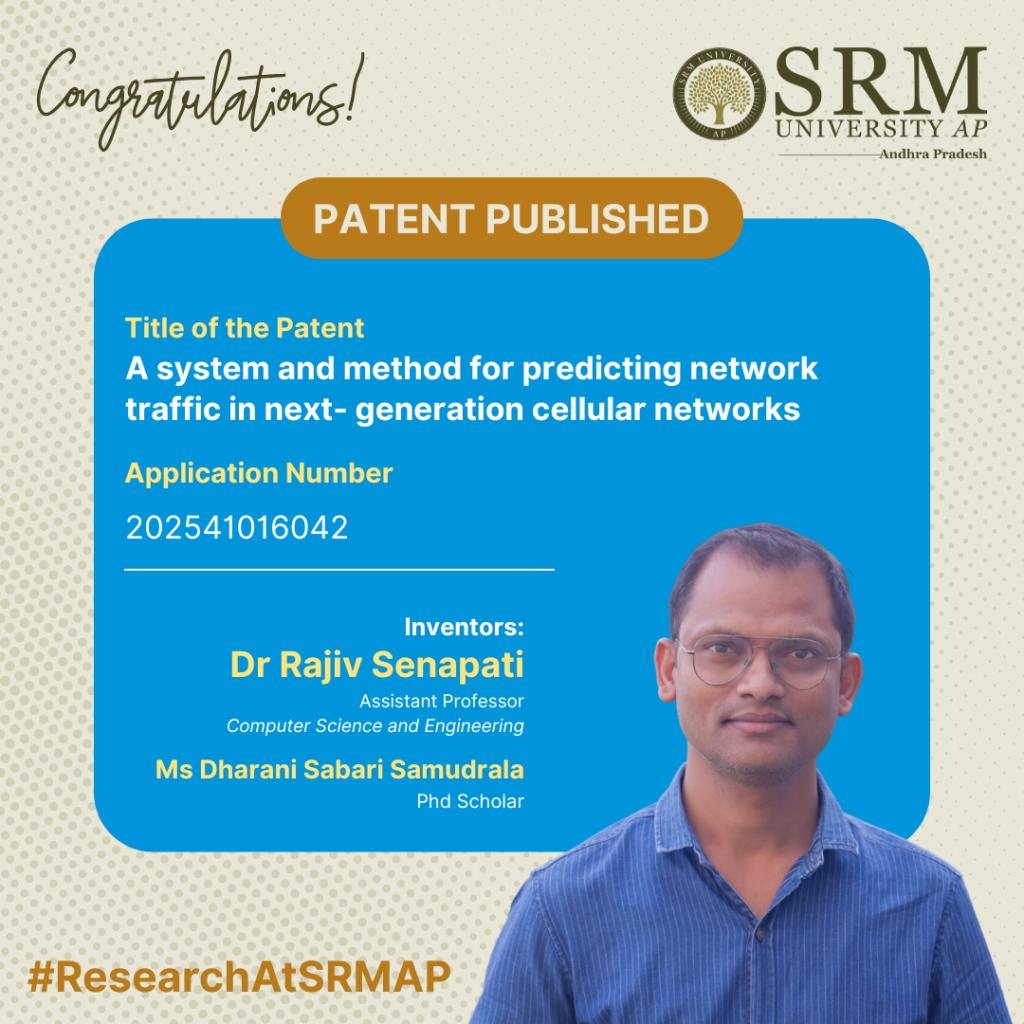
Dr Rajiv Senapati, Assistant Professor, Department of Computer Science and Engineering, along with Dharani Sabari, Ph.D. scholar has published a patent titled “A System And Method For Predicting Network Traffic in Next-Generation Cellular Networks” in the Patent Office Journal. Through their research, they introduced a new model that can predict traffic in networks more accurately while using fewer resources.
Abstract
This study shows a more advanced way to predict traffic in 5G networks. It does this by using a temporal attention mechanism along with a lightweight convolutional layer and hybrid attention layers. The model enhances prediction accuracy by focusing on the most relevant historical data to effectively capture complex traffic patterns. By assigning different weights to key data points, the attention mechanism ensures more precise forecasting. Experimental results indicate that the model outperforms baseline methods, achieving lower Mean Absolute Error (MAE) and Root Mean Square Error (RMSE) across three data services. With fewer parameters and reduced computational demands, the model is highly efficient and suitable for real-time applications. This approach offers a scalable and accurate solution to meet the evolving needs of next-generation cellular networks.
Explanation in Layperson’s Terms
In 5G networks, accurately predicting traffic is crucial to managing resources efficiently and ensuring smooth performance. This is especially important for advanced applications like video calls, virtual reality, and self-driving cars, which require fast response times and reliable connections. By estimating how much data will be used in advance, networks can prevent congestion and maintain consistent service, even during busy times. There are many ways to predict network traffic, but each method has strengths and weaknesses.
Through their research, they introduce a new traffic prediction model that combines two advanced techniques: lightweight convolution and a temporal attention mechanism. Lightweight convolution is a simplified machine-learning method that quickly identifies important patterns in data with minimal processing power. Meanwhile, the temporal attention mechanism captures how network traffic changes over time, identifying key trends and fluctuations. By combining these techniques, the model predicts traffic more accurately while using fewer resources. Tests indicate it outperforms traditional methods by providing more precise predictions with lower errors across three different types of network data. Its low computing power requirements and fewer parameters, make it faster and well-suited for real-time use in 5G networks. Their innovative approach offers a scalable and accurate solution to meet the growing demands of modern, data-heavy applications.

Fig (1) Proposed framework

Fig (2) Architecture of the proposed framework
Practical Implementation/Social Implications of the Research
The invention has important applications in smart cities, self-driving vehicles, network resource management, and real-time traffic monitoring. It optimizes traffic flow, improves autonomous car navigation, efficiently manages network capacity, and provides navigation systems with up-to-date traffic data. The advantages include increased quality of service with low latency, energy savings through intelligent resource allocation, scalability to accommodate more connected devices, and better overall user experience with less congestion. These characteristics make the invention an appropriate solution for the rapidly growing 5G network environment, addressing significant challenges in modern traffic and network management.
Future Research Plan
The team will focus on enhancing the model for both 5G and emerging 6G networks by improving traffic prediction accuracy and efficiency. This includes optimising resource allocation and capacity estimation to better manage network demands. Future work will also integrate diverse data sources, such as IoT devices and satellite networks, to improve predictions across different environments. Additionally, efforts will be made to reduce computational costs, enable dynamic traffic adaptation during peak times, and explore advanced AI techniques like federated learning for secure, real-time forecasting. These advancements aim to ensure more reliable and efficient network performance as technology evolves.
- Published in CSE NEWS, Departmental News, News, Research News


